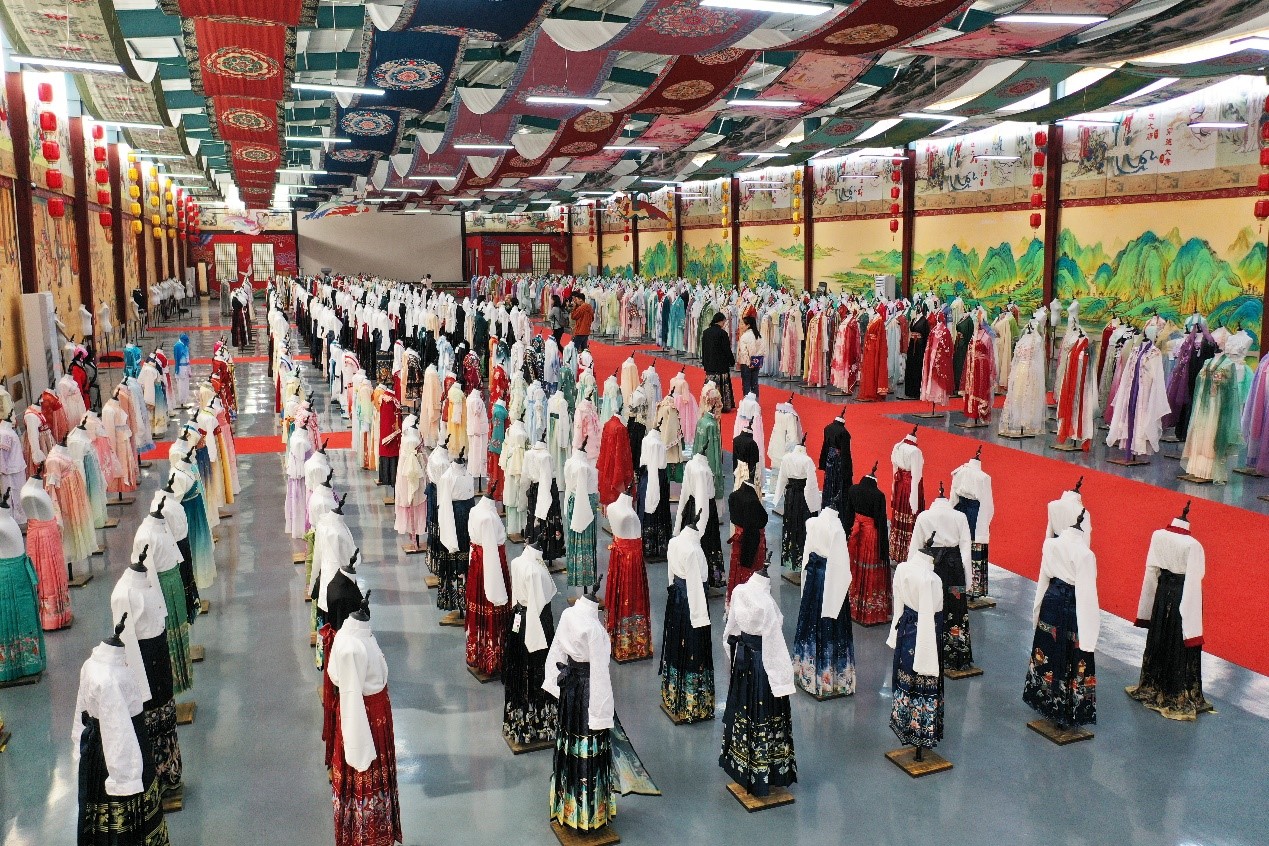E-commerce boosts Hanfu industry in Caoxian, E China's Shandong
In recent years, Hanfu, especially the horse-faced skirt known as the mamianqun in Chinese, has gained popularity as an important symbol of traditional Chinese attire. Noted for its elegant craftsmanship, the mamianqun has become popular on e-commerce platforms, reflecting a growing trend of showcasing and embracing China's cultural heritage.

Photo shows exquisite horse-faced skirts, known as mamianqun in Chinese. (Photo courtesy of the Publicity Department of the Communist Party of China Caoxian County Committee)
The rapid rise of the mamianqun was not by chance. Zhang Longfei, director of an e-commerce service center in Caoxian county, east China's Shandong Province, explained that the county government has invested significant effort in bolstering e-commerce, adjusting the industrial structure, building service carriers, connecting with livestreaming platforms, and cultivating livestreaming talent to capitalize on the new opportunities presented by livestreaming e-commerce.
Zhao Fulong, Party chief of Caoxian county, reported that the county is home to 2,282 Hanfu companies and 13,989 online stores involved in the industry.
Thanks to the mamianqun's popularity on Douyin, a popular short-video platform, the county has introduced 124 offline Hanfu experience stores and 170 studios. More than 90 percent of the Hanfu designs are original, creating a complete industry chain and brand incubation system that includes design, cutting, embroidery, printing, and finished clothing.

Workers make horse-faced skirts, known as mamianqun in Chinese, at a workshop in Caoxian county, east China's Shandong Province. (Photo courtesy of the Publicity Department of the Communist Party of China Caoxian County Committee)
This expansion has boosted employment opportunities, with nearly 100,000 individuals working in the county's Hanfu sector.
In just the first two months of this year, sales of horse-faced skirts in Caoxian reached nearly 550 million yuan ($76 million).
"The industrial network in Caoxian county used to be fragmented and lacked refinement," said Yao Chixing, general manager of an original Hanfu brand. In 2023, Yao and her husband established a Hanfu production hub covering 130 mu (8.66 hectares) centered on e-commerce, aiming to consolidate resources and develop a complete industrial chain.

Photo shows horse-faced skirts, known as mamianqun in Chinese, on display. (Photo courtesy of the Publicity Department of the Communist Party of China Caoxian County Committee)
Yao also launched her own Hanfu brand, specializing in skirts that feature more intricate craftsmanship, such as the six-pleat design. This move aims to meet the daily wear requirements of a broader range of consumers, expand their export business, and appeal to the high-end market.

A livestreamer promotes Hanfu during a livestreaming session. (Photo courtesy of the Publicity Department of the Communist Party of China Caoxian County Committee)
The surge in orders for mamianqun has led to a labor shortage, significantly boosting local women's reemployment rates and attracting young people back to the area. This influx has revitalized the industry and the region, offering a new direction for growth.
A decade ago, Hanfu was largely overlooked in China, perceived merely as performance costumes or unconventional dress, according to a Hanfu enthusiast named Sen Sen. Early promoters faced challenges such as scarce information, often having to create their samples themselves by collaborating with factories directly.
The Hanfu market has matured over time, with an increasing number of influencers showcasing Hanfu in their attire. Platforms like Douyin have seen a surge in Hanfu interest and transformation videos. Moreover, livestreaming platforms now feature a variety of Hanfu styles, allowing viewers to appreciate their beauty and envision themselves wearing these outfits.
Photos
Related Stories
- Wearing traditional Chinese clothing while visiting scenic spots becomes a hit with young people
- Hanfu beauty shines at cherry blossom festival
- Hanfu enthusiasts demonstrate traditional Huazhao Festival ceremony in U.S.
- Hanfu enthusiasts display Hanfu in London, Britain
- Feature: Hanfu show enriches Spring Festival celebrations in Malta
- Travel back in time and explore the beauty of Hanfu
Copyright © 2024 People's Daily Online. All Rights Reserved.









